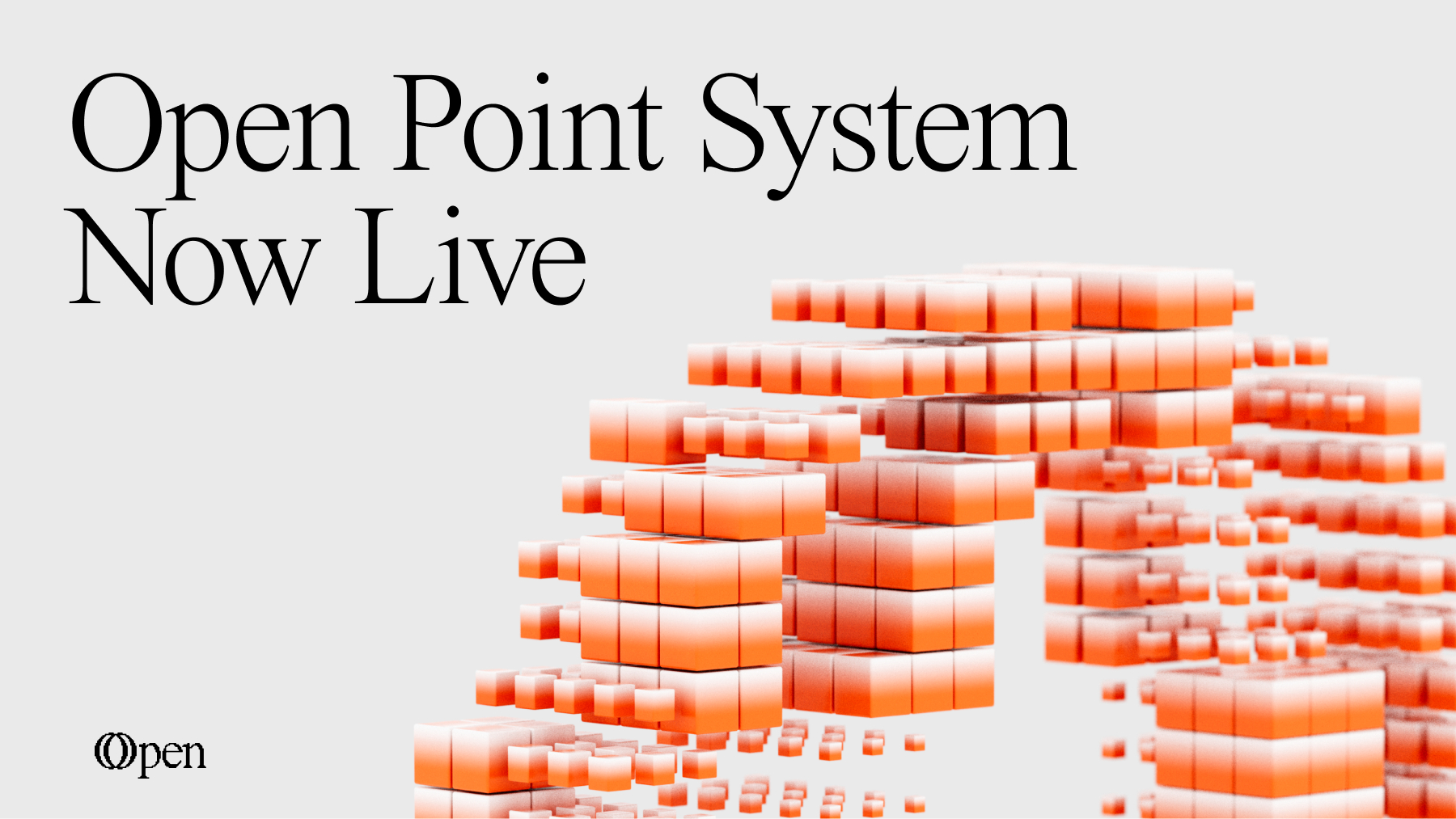
San Francisco, California, January 7th, 2025, Chainwire On-chain interaction with selected Open ecosystem projects will now grant users $OPEN points. The list of the first batch of eligible projects that can earn users $OPEN points includes AISweat.Shop, Overlord.bot, Gameboi.ai, OpenDeSci Platform, with more incoming to be disclosed at https://webisopen.com/ The points from the previous @owlonmusk_ campaign will be automatically bridged/converted to $OPEN points. Check the previous campaign here: https://x.com/Owlonmusk_/status/1856245362870411344 The exact calculation of $OPEN points and utilities are yet to be disclosed. Details should soon be available at https://webisopen.com/ In addition, all Open ecosystem projects such as AiSweat.Shop (ASS), Open DeSci Platform, Overlord.bot, Follow and more are expected to generate long term incentives for Open stakeholders. What is Open? The core technology of Open is the Open Virtual Machine (OVM). OVM powers blockchains with limitless, scalable, decentralized, and verifiable compute power, giving rise to possibilities of compute-intensive applications such as AI training, scientific simulations (DeSci) and complex financial algorithm executions, all done on-chain, in an immutable, transparent and verifiable manner. OVM as the Wormhole for Complex Compute OVM serves as a bridge between blockchain’s on-chain immutability and the scalability of decentralized compute, enabling blockchain networks to run sophisticated applications like decentralized AI and scientific simulations (DeSci). By leveraging OVM, blockchains can now support advanced computations, unlocking new possibilities for high-performance, decentralized ecosystems. This architecture supports a broad range of use cases, from AI-driven decentralized apps to complex financial models, all while preserving the immutability, verifiability, scalability, high performance computability, and decentralization of on-chain operations. OVM – Verifiable AI Infrastructure On-Chain AI and Machine Learning: OVM enables resource-intensive AI and ML computations on-chain, supporting advanced applications and agents like autonomous trader AI agents, sentient sentiment agents, predictive models and personalized execution assistants while maintaining verifiability. For example, AiSweat.Shop: AiSweat.Shop (A.S.S.) is built with the AI infrastructure of Open (also known as webisOpen on X, collective includes RSS3). It allows Easy deployment of autonomous AI Agents with various decentralized financial abilities (DeFi) and the tokenization of DeAI-Fi Agents. Verifiable DeSci The Open Virtual Machine (OVM) offers a high-performance, decentralized, and verifiable compute layer, designed to democratize access to advanced computational resources. Its implementation begins with a demonstration and experimental applications on-chain analysis of genetic similarities between two viruses: SARS-CoV-2 (sequenced in Wuhan, 2019) and SARS-CoV (sequenced in Toronto, 2003) on the Open DeSci Platform, showcasing its capabilities in bridging decentralized computation with the immutability of blockchain technology. By bridging powerful decentralized computation with blockchain immutability, OVM is a Data Wormhole for innovations like verifiable and transparent AI and DeSci. This analysis is performed fully on-chain using Open’s Open Virtual Machine (OVM) within a Trusted Execution Environment (TEE) (together known as Open’s Compute Wormhole) utilizing and bridging decentralized compute from Hyperbolic Labs, to ensure integrity, immutability, determinism, and resistance to tampering. Additionally, OVM guarantees verifiability through on-chain transactions, promoting transparency and trust in the results. This demo and experiment of Open Desci Platform Alpha and its record on-chain (on Open Chain) has also been released to the public to showcase the power of OVM to the public. Users can check out this link for more information. Reproducibility Guaranteed: Every computation is verifiable and reproducible, a critical feature for peer-reviewed scientific research. Secure Data Processing: A built-in Trusted Execution Environment (TEE) safeguards sensitive data, ensuring integrity and tamper resistance throughout the computational process. Effortless Genomic Analysis: Researchers can now compare viral genomes, such as [SARS-CoV-2] and [SARS-Tor-2], in a decentralized and democratized manner, without permission and access to exclusive and expensive hardware. These capabilities can highlight the expanding potential of OVM in decentralized science (DeSci), paving the way for further innovations in transparent and democratized research. OVM – Compute Lego OVM extends blockchain’s functionality by enabling verifiable decentralized compute, allowing blockchains to securely harness limitless high performance computing power while preserving blockchain immutability and verifiability. Through its modular and scalable design, OVM enables different blockchains to be combined and integrated with decentralized compute like Lego blocks, whether for AI models or decentralized science (DeSci). OVM – Institutional DeFi Infrastructure Complex Financial Modeling: Ideal for DeFi applications, OVM allows for on-chain risk assessments, yield optimizations, and real-time derivatives pricing with verifiable and scalable compute, bringing institutional-grade modeling to on-chain decentralized finance. OVM – Gaming & Metavere Simulations OVM provides the sufficient decentralized and verifiable computational power for real-time simulations, NFT generation, and complex in-game economies on-chain, enhancing the trust and security of assets in decentralized gaming and virtual worlds. Open Ecosystem Apart from the experiments and initiatives mentioned, the Open Ecosystem has projects ranging from AI, information, socials, infrastructure, middleware, finance, data sources, creatives and media. Together Open accelerates the course of the open web. About Open (aka webisOpen on X) Open is a series of endeavors aimed at propelling the Open Web forward. Collectively, Open is the Data and Compute Wormhole for innovations like verifiable and transparent AI and DeSci. The Open ecosystem includes @RSS3_ @_RSSHub & @openinfo_ . webisOpen. Contact Marketing Lead KM KM Open Collective km@open.network
CryptoIntelligence
You can visit the page to read the article.
Source: CryptoIntelligence
Disclaimer: The opinion expressed here is not investment advice – it is provided for informational purposes only. It does not necessarily reflect the opinion of BitMaden. Every investment and all trading involves risk, so you should always perform your own research prior to making decisions. We do not recommend investing money you cannot afford to lose.
Bybit Recovers Strongly from February Hack as Capital Inflow Soars in March

Bybit has made a remarkable turnaround after suffering a high-profile hack in February. Its capital inflow in March was nothing short of impressive. Data from DeFiLlama shows that Bybit’s capital inflow in March reached an astonishing $3.61 billion, the highest among all centralized exchanges (CEXs) for the month. This, obviously, is a significant recovery for the platform and a testament to probably effective crisis management. 1. Retrieving lost capital after a hack is a difficult task for any exchange. 2. Most hacked exchanges tend to either collapse completely or exist in a zombie state. 3. Even the hacked CEX in question (in this case, Bybit) has managed to hang on to a fair amount of customer trust. 4. This article will explore the implications of Bybit’s recovery. After a tough few weeks following the hack, Bybit is coming back strong. The hack was bad, of course—the breach in security that led to the theft of user funds was never going to be an easy thing to deal with. But if a company can manage a life-threatening event and come out strong on the other side, there will surely be many Bybit loyalists living in a world where they can feel normal again. And with Bitcoin and other cryptocurrencies surging, Bybit may very well be back in play. Bybit’s Recovery Plan: Transparency and Asset Reserves After the hack, Bybit took immediate and decisive action to manage the crisis. One of the key aspects of Bybit’s recovery strategy was its commitment to being transparent. The exchange quickly shared detailed updates with its users about the situation and the steps being taken to rectify the breach. In an effort to ensure that customer funds were fully protected, Bybit emphasized something very important—its asset-sharing—a concept that corresponds 1:1 with every user deposit. This was, for a good number of users, a very reassuring communication strategy. Bybit shared updates, gave some specialized interviews, and kept on communicating. This was almost a “overcommunication” strategy—lots of users who might have been teetering on the edge of returning to the site got this honesty as a confidence boost. Besides transparency, Bybit prioritized recovering the stolen funds. The security team at the company worked day and night tracing the pilfered assets and collaborating, where necessary, with authorities to identify the bad guys. This effort also helped with user reassurance. Moreover, Bybit took proactive measures to manage the fallout from the hack by supervising 350,000 withdrawal requests that had built up during the uncertain time. The handling of this situation allowed users who wanted to access their funds to do so quickly and without extra hassle. Going into damage control mode with this process helped Bybit fix its reputation enough to concentrate on the recovery from the breach. DeFiLama shows that after being hacked in February, Bybit`s capital inflow in March reached $3.61 billion, ranking first among all CEXs, indicating that its customers are returning after the hack. Binance`s inflow in March was $3.545 billion, ranking second. Currently, the total… pic.twitter.com/mstyw3SZ13 — Wu Blockchain (@WuBlockchain) April 1, 2025 March Inflow: A Strong Showing from Bybit Bybit’s successful recovery was most clearly illustrated in March when the exchange saw a whopping influx of capital. With $3.61 billion in capital inflow, Bybit led all centralized exchanges, even ahead of Binance, which saw an inflow of $3.545 billion in the same time frame. The fact that Bybit managed to attract this enormous amount of new capital, in spite of the hack it experienced earlier in the year, is a pretty strong testament to the platform’s resilience and the way it has managed to reassure its users. Bybit has total capital inflows of $15.133 billion—indicative of both its recovery and continued growth. Those figures suggest that not only is the user base returning, but there’s renewed trust in operations and security. Given the volatile nature of the crypto space and the heightened risks associated with exchange hacks, Bybit’s performance (in capital inflows, at least) is all the more impressive. Binance’s Strong Position Amid Bybit’s Recovery Even though Bybit had impressive inflows in March, it wasn’t the only exchange experiencing that trend. Binance, the world’s largest cryptocurrency exchange, also had a strong inflow of $3.545 billion in March, landing it in second place, just behind Bybit. This suggests that, despite the competition from exchanges like Bybit, users still trust Binance and are sending it a significant amount of capital. Trust in centralized exchanges appears to be growing, as evidenced by the large inflows seen by both Binance and Bybit in March. These inflows occurred just months after a significant security breach at Bybit, yet they indicate an intrinsic, upward trust trend for both platforms. This upward trust trend underscores the ability of both platforms to maintain user confidence, even when strong evidence points to possible, user-destroying security vulnerabilities in the places where users hold their crypto. The space between the two platforms is made clear by the finding that, in fact, there is no space—the ability of the two platforms to maintain confidence just might be a `crypto` manager’s textbook illustration of how to handle a breach, by being open and transparent. Looking Ahead: A Competitive Landscape The competitive structure of the centralized exchange market is changing while Bybit recovers from the hack. Binance and Bybit are both doing very well, yet Bybit’s sharp recovery is a clear sign that it is not only back but also looking to capture market share. If the platform can keep improving its fortifications and maintain a fundamentally sound, super transparent way of dealing with user troubles, that’s a good sign for it in terms of strength, stability, and position in the market. Additionally, the March data sheds light on the user trust in the cryptocurrency exchange ecosystem. Exchanges that offer not just innovative products and services but also the security and transparency users demand will likely be the ones that thrive in the long run. Bybit’s recovery serves as a model for how exchanges can bounce back from such security incidents, with a laser focus on asset reserves, clear and concise communication with users, and a quick response to user needs. The market is changing. How other world exchanges will adapt to the increasing demand for safe, easy-to-use platforms remains to be seen. But today, Bybit’s impressive resurgence makes it about as close to a guaranteed thing as you can get in this market. It is a testament to the platform’s resilience and the regained trust of the platform’s user base. Disclosure: This is not trading or investment advice. Always do your research before buying any cryptocurrency or investing in any services. Follow us on Twitter @nulltxnews to stay updated with the latest Crypto, NFT, AI, Cybersecurity, Distributed Computing, and Metaverse news ! CryptoIntelligence

New Legislation Sets Clear Rules for Digital Payment Systems in the US
The STABLE Act aims to clarify regulations for digital payment systems in the US. It enhances consumer protection and supports the USD`s global role. Continue Reading: New Legislation Sets Clear Rules for Digital Payment Systems in the US The post New Legislation Sets Clear Rules for Digital Payment Systems in the US appeared first on COINTURK NEWS . CryptoIntelligence











